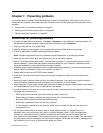
Updating your system UEFI BIOS
The Unied Extensible Firmware Interface (UEFI) BIOS is a part of the system programs that make up the
basic layer of software built into your computer. The UEFI BIOS translates the instructions from other
software layers.
Your computer system board has a module called EEPROM, also referred to as ash memory. You can
update the UEFI BIOS and the ThinkPad Setup program by starting your computer with a ash update
optical disc or ash update program running in the Windows environment.
In some instances when you add software, hardware, or a device driver, you might be informed that you
need to update your UEFI BIOS in order for the new addition to work properly.
To update your UEFI BIOS, go to the following Web site and follow the instructions on the screen:
http://www.lenovo.com/ThinkPadDrivers
Using system management
This section is intended primarily for network administrators.
Your computer is designed for manageability, so that you can redirect more of your resources to better
meet your business objectives.
This manageability, or “Total Cost of Ownership” (TCO), enables you to remotely operate client computers
in the same way as you operate your own computer, such as turning on a client computer, formatting
solid-state drive, and installing software.
Once the computer is congured and operational, you can manage it by use of software and manageability
features already integrated into the client system and the network.
System management
Read this topic to learn more about features of system management.
Desktop Management Interface
The system BIOS (UEFI BIOS) of your computer supports an interface called System Management BIOS
Reference Specication (SMBIOS) V2.6.1. SMBIOS provides information about the hardware components
of your system. It is the responsibility of the BIOS to supply this database with information about itself
and the devices on the system board. This specication documents the standards for getting access to
this BIOS information.
Preboot eXecution Environment
The Preboot eXecution Environment (PXE) technology makes your computer more manageable (it is PXE
2.1-compliant) by enabling it to boot (load an operating system or another executable image) from a
server. Your computer supports the personal computer functions that PXE requires. For example, with the
appropriate LAN card, your computer can be booted from the PXE server.
Note: Remote Program Load (RPL) cannot be used with your computer.
Asset ID EEPROM
The Asset ID EEPROM contains information about the system, including its conguration and the serial
numbers of key components. It also includes a number of blank elds in which you can record information
about the end users in your network.
84 User Guide


















